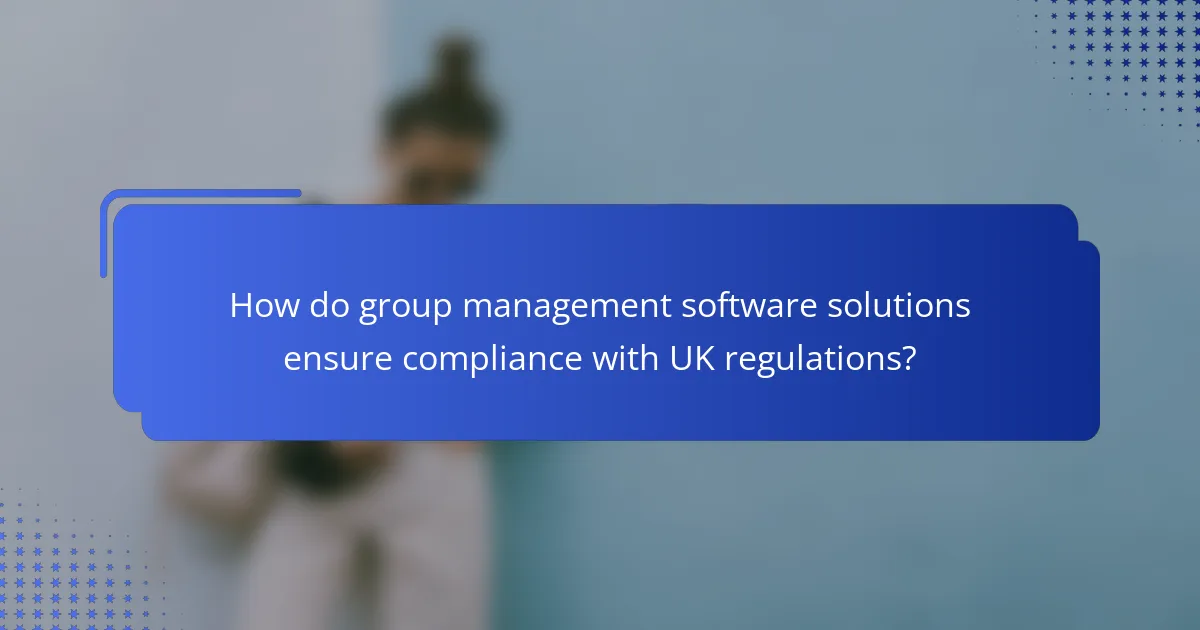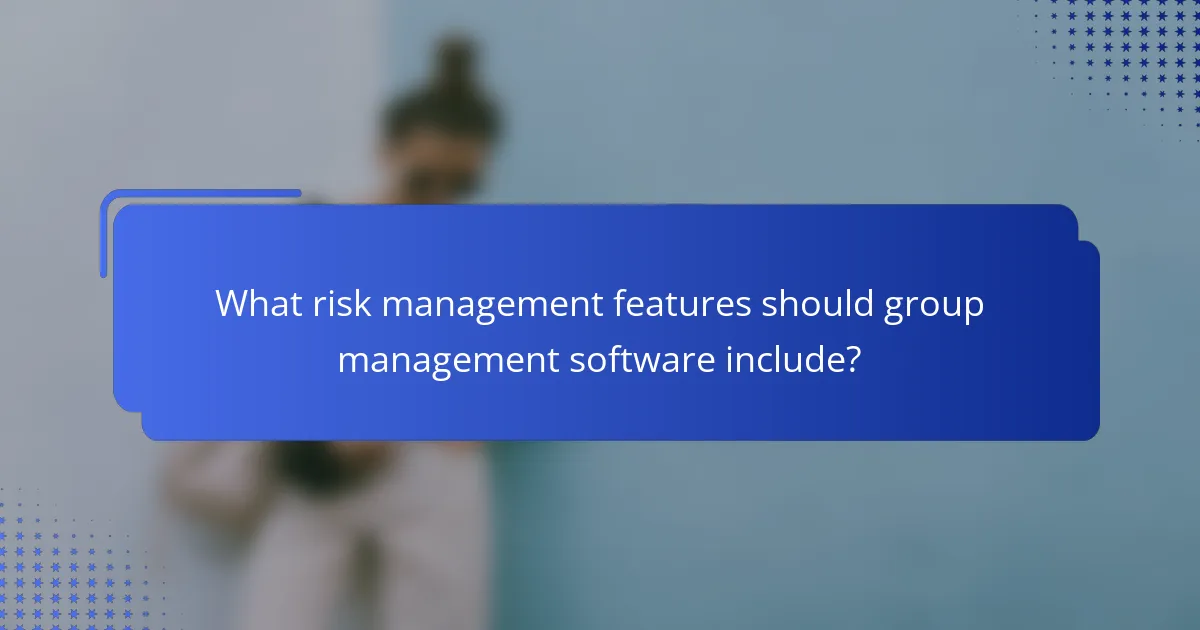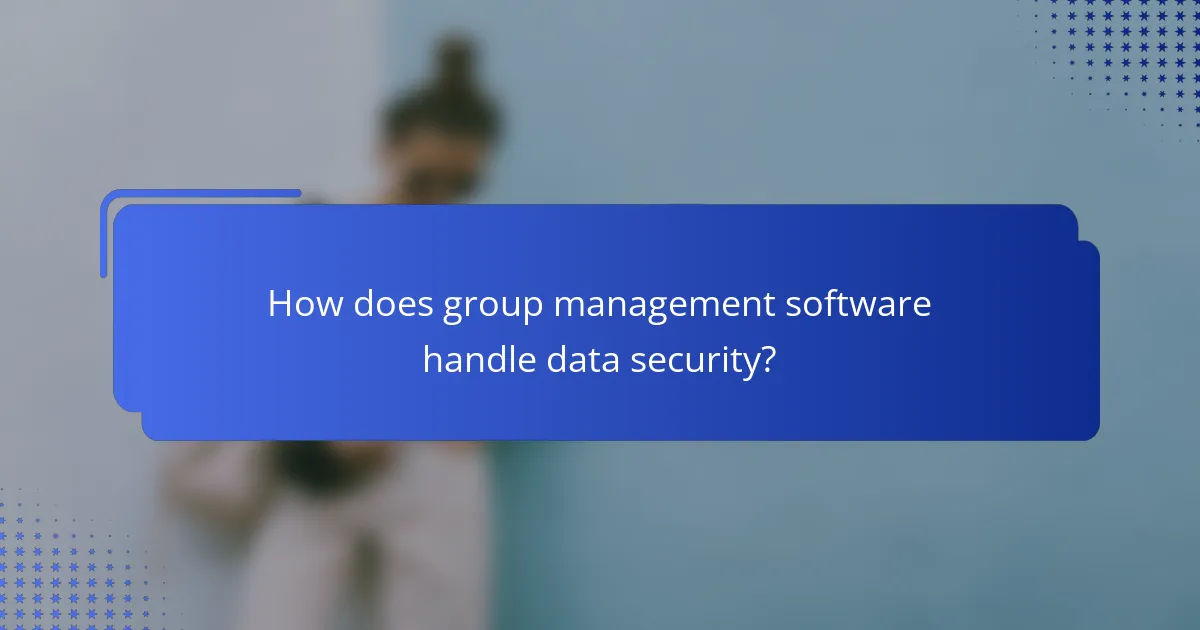In today’s digital landscape, effective group management software is essential for ensuring security protocols, compliance, and risk management. These solutions prioritize data protection and user privacy, aligning with regulations like GDPR while providing robust features for collaboration. By incorporating tools for incident reporting, risk assessment, and audit trails, organizations can effectively identify and mitigate risks, ensuring a secure and compliant environment.

What are the best group management software solutions for security protocols in the UK?
The best group management software solutions for security protocols in the UK prioritize data protection, user privacy, and compliance with regulations like GDPR. These platforms offer robust features to safeguard sensitive information while facilitating effective collaboration among teams.
Microsoft Teams
Microsoft Teams is a leading group management software that integrates seamlessly with Microsoft 365, providing strong security protocols. It employs end-to-end encryption for data in transit and at rest, ensuring that sensitive information remains protected.
Additionally, Teams supports compliance with various regulations, including GDPR, by offering features like data loss prevention and information governance. Users can customize security settings to align with their organization’s policies, making it a flexible choice for UK businesses.
Slack
Slack is another popular group management tool known for its user-friendly interface and strong security measures. It offers enterprise-grade encryption and supports compliance with standards such as GDPR, making it suitable for UK organizations handling sensitive data.
Slack allows administrators to manage user access and permissions effectively, enhancing security. Regular audits and compliance checks are also part of its offerings, ensuring that teams can collaborate securely while adhering to legal requirements.
Asana
Asana focuses on project management but includes essential security protocols to protect user data. It offers features like two-factor authentication and encryption, which help safeguard project information from unauthorized access.
Asana is compliant with GDPR and provides users with tools to manage data privacy effectively. Organizations can set up custom security settings to ensure that sensitive project details remain confidential while promoting team collaboration.
Trello
Trello is a visual project management tool that incorporates security measures to protect user data. It uses encryption for data in transit and at rest, ensuring that information shared on boards is secure.
While Trello is user-friendly, organizations should be mindful of its compliance features. Users can integrate Trello with other security tools to enhance data protection and ensure adherence to regulations like GDPR, making it a viable option for UK teams.
Basecamp
Basecamp is designed for team collaboration and project management, featuring strong security protocols to protect user data. It employs SSL encryption and offers user permissions to control access to sensitive information.
Basecamp is committed to compliance with GDPR, providing users with tools to manage their data privacy effectively. Its straightforward approach to security makes it a practical choice for UK organizations looking to enhance team collaboration while maintaining data integrity.

How do group management software solutions ensure compliance with UK regulations?
Group management software solutions comply with UK regulations by implementing features that align with legal requirements, particularly those related to data protection and privacy. These solutions often include built-in mechanisms for monitoring, reporting, and securing sensitive information.
GDPR Compliance Features
GDPR compliance is crucial for group management software operating in the UK, as it governs the handling of personal data. Key features include data subject rights management, which allows users to access, rectify, or delete their data easily. Additionally, software must provide transparency in data processing activities and maintain records of consent.
To ensure compliance, organizations should regularly audit their software for GDPR adherence and train staff on data protection best practices. Utilizing tools that automate compliance checks can help mitigate risks associated with non-compliance.
Data Encryption Standards
Data encryption is a fundamental security measure for protecting sensitive information within group management software. Solutions should employ strong encryption standards, such as AES-256, to secure data both at rest and in transit. This ensures that unauthorized users cannot access confidential data even if they gain access to the system.
Organizations should evaluate their software providers’ encryption protocols and ensure they meet industry standards. Regularly updating encryption methods is essential to counter evolving security threats.
User Access Controls
User access controls are vital for maintaining compliance with UK regulations by limiting who can view or manipulate sensitive data. Effective software solutions implement role-based access controls (RBAC), allowing administrators to assign permissions based on user roles within the organization.
To enhance security, organizations should regularly review user access levels and promptly revoke permissions for users who no longer require access. Implementing multi-factor authentication (MFA) can further strengthen user access controls and reduce the risk of unauthorized access.

What risk management features should group management software include?
Group management software should include features that facilitate effective risk management, such as incident reporting tools, risk assessment frameworks, and audit trail capabilities. These elements help organizations identify, analyze, and mitigate risks while ensuring compliance with relevant regulations.
Incident Reporting Tools
Incident reporting tools allow users to document and report any security breaches or compliance issues in real-time. This feature is crucial for maintaining transparency and accountability within the organization. Effective tools should enable users to categorize incidents, attach relevant documentation, and track the resolution process.
When selecting incident reporting tools, consider those that integrate seamlessly with existing software systems. Look for features such as automated notifications and customizable reporting templates to streamline the process. Regular training on how to use these tools can also enhance their effectiveness.
Risk Assessment Frameworks
Risk assessment frameworks provide structured methodologies for identifying and evaluating potential risks within an organization. These frameworks typically involve assessing the likelihood and impact of various risks, allowing organizations to prioritize their risk management efforts. Common frameworks include ISO 31000 and NIST SP 800-30.
When implementing a risk assessment framework, ensure it aligns with your organization’s specific needs and regulatory requirements. Regularly review and update the framework to adapt to changing circumstances, such as new technologies or regulatory changes. Engaging stakeholders in the assessment process can also enhance its effectiveness.
Audit Trail Capabilities
Audit trail capabilities enable organizations to track and document all user activities within the group management software. This feature is essential for maintaining compliance with regulations and for conducting thorough investigations in case of incidents. A robust audit trail should include timestamps, user IDs, and detailed descriptions of actions taken.
When evaluating audit trail capabilities, look for software that offers easy access to historical data and customizable reporting options. Regular audits of the audit trail can help identify unusual patterns or potential security threats. Ensure that your team understands the importance of maintaining accurate records for compliance purposes.

What are the key criteria for selecting group management software?
When selecting group management software, prioritize integration capabilities, scalability, and user experience. These criteria ensure that the software meets your organization’s needs, adapts to growth, and is user-friendly for all team members.
Integration with Existing Tools
Effective group management software should seamlessly integrate with your current tools, such as project management systems, communication platforms, and file storage solutions. Look for software that supports popular APIs and offers plugins for widely used applications.
Before making a decision, assess how well the software can connect with your existing infrastructure. A good integration can save time and reduce errors, while poor integration may lead to data silos and inefficiencies.
Scalability Options
Scalability is crucial for group management software, especially for growing organizations. Choose software that can accommodate an increasing number of users and projects without sacrificing performance.
Consider whether the software offers tiered pricing plans or additional features that can be unlocked as your needs evolve. This flexibility can help manage costs while ensuring that the software remains effective as your team expands.
User Experience and Interface
A user-friendly interface enhances productivity and encourages team adoption. Evaluate the software’s design, navigation, and overall usability to ensure it meets the needs of your team members.
Conduct trials or gather feedback from potential users to gauge their comfort level with the interface. A software solution that is intuitive can significantly reduce training time and improve overall satisfaction among users.

How does group management software handle data security?
Group management software employs various data security measures to protect sensitive information. These measures typically include encryption, access controls, and regular security audits to ensure compliance with industry standards.
Encryption methods used in group management software
Encryption is a critical component of data security in group management software. It transforms sensitive data into unreadable formats, ensuring that only authorized users can access it. Common encryption methods include AES (Advanced Encryption Standard) and RSA (Rivest-Shamir-Adleman), which are widely recognized for their effectiveness.
When selecting software, consider whether it uses end-to-end encryption, which secures data from the point of origin to the destination. This adds an extra layer of protection against potential breaches during data transmission.
Access control mechanisms
Access control mechanisms determine who can view or manipulate data within group management software. Role-based access control (RBAC) is a popular method that assigns permissions based on user roles, ensuring that individuals only have access to the information necessary for their tasks.
Implementing multi-factor authentication (MFA) can further enhance security by requiring users to provide additional verification, such as a code sent to their mobile device. This reduces the risk of unauthorized access significantly.
Compliance with data protection regulations
Compliance with data protection regulations is essential for group management software to ensure legal operation and protect user data. Regulations such as GDPR (General Data Protection Regulation) in Europe and CCPA (California Consumer Privacy Act) in the U.S. set strict guidelines on data handling and user privacy.
When evaluating software, verify that it adheres to relevant regulations. Look for features like data anonymization and user consent management, which help organizations comply with legal requirements while maintaining user trust.
Risk management strategies
Risk management strategies in group management software involve identifying, assessing, and mitigating potential security threats. Regular risk assessments can help organizations understand vulnerabilities and prioritize security measures effectively.
Establishing an incident response plan is crucial for addressing security breaches promptly. This plan should outline steps for containment, investigation, and communication, ensuring that organizations can respond quickly to minimize damage.
